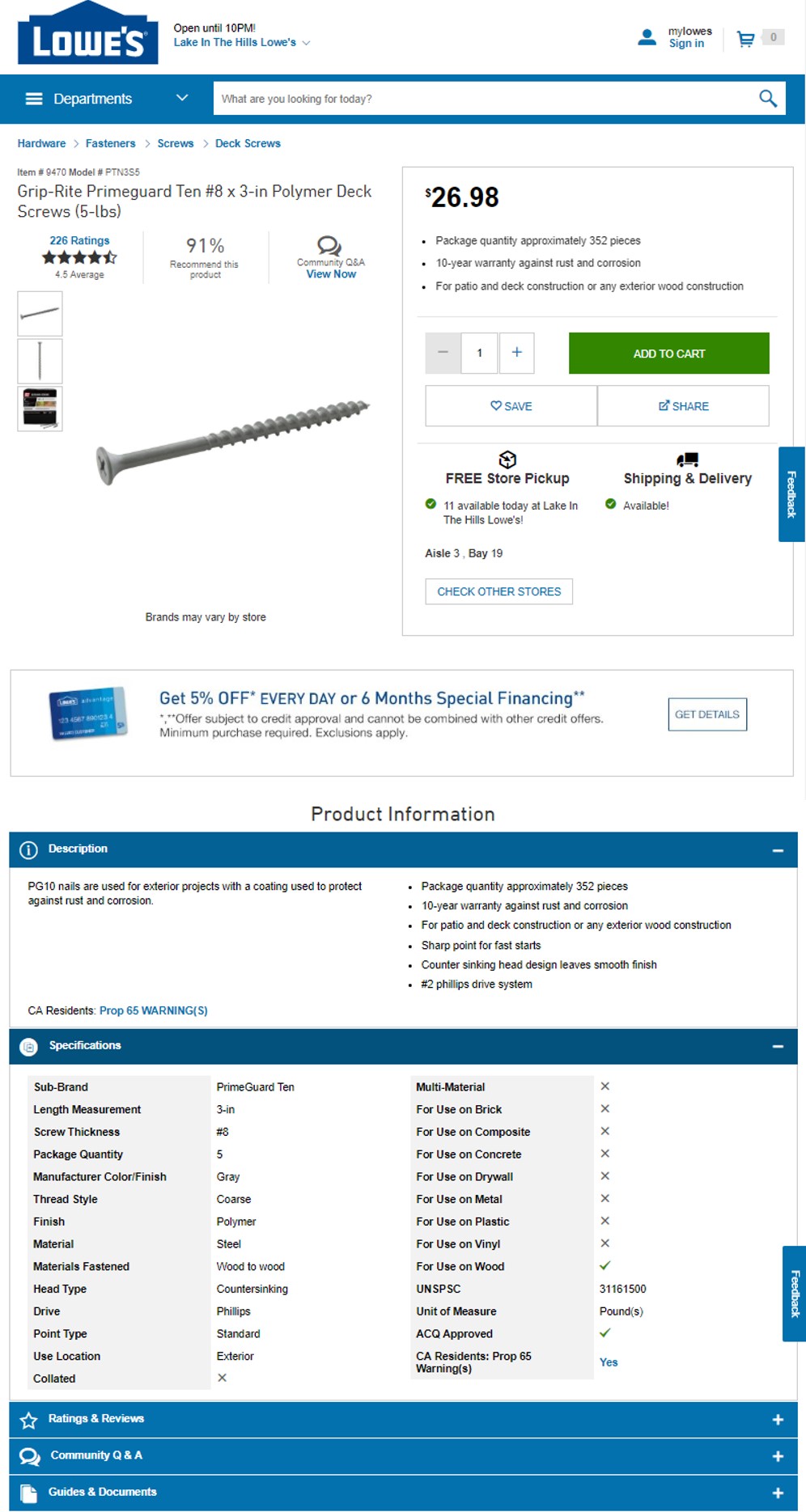User experience impacts organic search performance. A positive UX reduces bounces and encourages visitors to browse and purchase. It drives ratings, referrals, and inbound links.
Moreover, optimizing a site for organic search when its UX is poor is like pouring shoppers into a sieve. You can keep filling the funnel, but the traffic will not likely convert.
These nine factors influence user experience — and organic search traffic.
UX Influences on SEO
Highlight desirable features. Product pages are showcases to make each item sparkle. Write the romance copy that satisfies branding, but also include a list below the product description of the details people want to know to make a purchase decision.

This deck-screw product detail page on Lowe’s contains three areas broken out for details. Click image to enlarge.
In the image above, Lowe’s takes advantage of all available product attributes for this box of deck screws. Product details are in your database. Exposing all of them in your product pages can help searchers looking for a single, obscure detail. The merchant that surfaces that attribute on the product page is more likely to win the sale.
Select useful content topics. To attract organic search traffic, make sure article pages focus on topics that shoppers find helpful.
In many cases, those topics don’t align with how marketing teams describe the benefits of your brands.
Seek out the questions that real people ask, and then answer them thoughtfully and thoroughly. Take you and your brand out of it. These aren’t the questions you want them to ask. It’s the questions they do ask. For example, real people search for whether gel matters in a running shoe sole, or whether gel is better than memory foam or any other type of cushioning. They don’t search for brand-centric language on, say, Asics Gel technology.
If you want searchers to find your content, provide the answers they are looking for.
Go in depth. Length alone doesn’t ensure rankings. But longer content tends to contain more of the natural language variations and contextual references that inform search engines on what you’re writing about.
If your topic can be answered in 200 words in a quick question-and-answer format, don’t belabor the point to drive length. But if the topic merits 4,000 words, don’t skimp.
Link to relevant pages. Search engine optimizers often overuse internal linking. For example, there’s no point in linking to the page you’re already on just to put a keyword link into the copy.
On the other hand, if you’re writing a page about the best types of screws to use for a deck, by all means link (once) to your deck screws browse-grid page.
Think of internal links as a service to help shoppers purchase the products you’re writing about. Do it for them, honestly. If helping the customer is your intent, you’re on the right trail.
Optimize honestly. Speaking of honest intent in service of the customer, choose your keyword themes and words carefully. Don’t use keywords solely to drive search volume. Use the words and themes that flow well within the copy and convey meaning to readers.
Also, if a product doesn’t include a feature or niche that people are looking for, don’t try to rank for those keywords. Otherwise, searchers that click to your site encounter products they don’t want or need.
Use the best content format. Use the content format that makes sense — whether it’s an image carousel, video, how-to steps, illustrations, or long-form text — to answer searchers’ needs. Google can algorithmically discern that the need wasn’t fulfilled and over time this “pogo stick” behavior can reduce rankings.
Whatever format you choose, make sure the content is around or below product video and images to enable search engines to understand relevancy.
Add engaging visuals. Search algorithms don’t yet include image recognition capabilities, even though Google Lens offers that ability. But consumers need visual content. A page of gray text is not appealing. But when sprinkled with useful images, that same copy becomes engaging. Make sure to optimize images as well.
Load pages quickly. Shoppers don’t wait for slow sites. A Google study showed conversions dropping by 12 percent for every second of load time. Optimizing page speed can drive longer time on site and produce higher organic rankings.
Enable customers to use any device. With Google’s mobile-first index serving most search results, it’s possible that your entire search presence is based on how your site performs on mobile.
Even if your site isn’t yet in the mobile-first index, your shoppers are increasingly trying to find you on their smartphones. If they have a poor mobile experience, they’ll leave.
You may think that you don’t need a mobile presence if data shows most visitors are on a desktop. But it’s possible Google isn’t sending mobile visitors because you don’t have a mobile-friendly site.
Ranking Factors
To be clear, only one of these nine UX influences — page speed — is a confirmed ranking factor. The others correlate strongly with higher rankings.
Lastly, some UX decisions can hurt organic search performance. I’ve address pitfalls to avoid, at “SEO: 8 Ways UX and Design Could Reduce Traffic.”